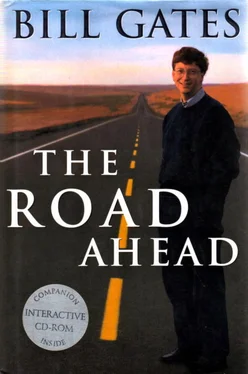THE ROAD AHEAD
by Bill Gates
with Nathon Myhrvold
and Peter Rinearson
Bringing a major software project to market can require the combined talents of hundreds of people. Not quite that many helped me with this book, but I certainly couldn’t have done it alone. If I’ve inadvertently left someone out below, I’m really sorry, and thank you too.
For everything from conception to marketing, and lots of stops along the way, thanks to Jonathan Lazarus and his team: Kelli Jerome, Mary Engstrom, Wendy Langen, and Debbie Walker. Without Jonathan’s guidance and persistence this book never would have happened.
For their helpful suggestions throughout the project, special thanks to Tren Griffin, Roger McNamee, Melissa Waggener, and Ann Winblad.
For their incisive review comments, thanks to Stephen Arnold, Steve Ballmer, Harvey Berger, Paul Carroll, Mike Delman, Kimberly Ellwanger, Brian Fleming, Bill Gates, Sr., Melinda Gates, Bernie Gifford, Bob Gomulkiewicz, Meg Greenfield, Collins Hemingway, Jack Hitt, Rita Jacobs, Erik Lacitis, Mich Matthews, Scott Miller, Craig Mundie, Rick Rashid, Jon Shirley, Mike Timpane, Wendy Wolf, Min Yee, and Mark Zbikowski.
For help with research, transcription, and resource material, my gratitude to Kerry Carnahan, Ina Chang, Peggy Gunnoe, Christine Shannon, Sean Sheridan, and Amy Dunn Stephenson. I’m also grateful to Elton Welke and his able staff at Microsoft Press, including Chris Banks, Judith Bioch, Jim Brown, Sally Brunsman, Mary DeJong, Jim Fuchs, Dail Magee, Jr., Erin O’Connor, JoAnne Woodcock, and Mark Young.
I’m also grateful to those at my English-language publisher, Viking Penguin, for their help and patience. In particular, I’d like to thank Peter Mayer, Marvin Brown, Barbara Grossman, Pamela Dorman, Cindy Achar, Kate Griggs, Theodora Rosenbaum, Susan Hans O’Connor, and Michael Hardart.
Thanks, too, for editorial help, go to Nancy Nicholas and Nan Graham.
My special gratitude to my collaborators, Peter Rinearson and Nathan Myhrvold.
The past twenty years have been an incredible adventure for me. It started on a day when, as a college sophomore, I stood in Harvard Square with my friend Paul Allen and pored over the description of a kit computer in Popular Electronics magazine. As we read excitedly about the first truly personal computer, Paul and I didn’t know exactly how it would be used, but we were sure it would change us and the world of computing. We were right. The personal-computer revolution happened and it has affected millions of lives. It has led us to places we had barely imagined.
We are all beginning another great journey. We aren’t sure where this one will lead us either, but again I am certain this revolution will touch even more lives and take us all farther. The major changes coming will be in the way people communicate with each other. The benefits and problems arising from this upcoming communications revolution will be much greater than those brought about by the PC revolution.
There is never a reliable map for unexplored territory, but we can
learn important lessons from the creation and evolution of the $120-billion personal-computer industry. The PC—its evolving hardware, business applications, on-line systems, Internet connections, electronic mail, multi-media titles, authoring tools, and games—is the foundation for the next revolution.
During the PC industry’s infancy, the mass media paid little attention to what was going on in the brand-new business. Those of us who were enthralled by computers and the possibilities they promised were unnoticed outside our own circles and definitely not considered trendy.
But this next journey, to the so-called information highway, is the topic of endless newspaper and magazine articles, television and radio broadcasts, conferences, and rampant speculation. There has been an unbelievable amount of interest in this subject during the last few years, both inside and outside the computer industry. The interest is not confined only to developed countries, and it goes well beyond even the very large numbers of personal-computer users.
Thousands of informed and uninformed people are now speculating publicly about the information highway. The amount of misunderstanding about the technology and its possible pitfalls surprises me. Some people think the highway—also called the network—is simply today’s Internet or the delivery of 500 simultaneous channels of television. Others hope or fear it will create computers as smart as human beings. Those developments will come, but they are not the highway.
The revolution in communications is just beginning. It will take place over several decades, and will be driven by new “applications"—new tools, often meeting currently unforeseen needs. During the next few years, major decisions will have to be made by governments, companies, and individuals. These decisions will have an impact on the way the highway will roll out and how much benefit those deciding will realize. It is crucial that a broad set of people—not just technologists or those who happen to be in the computer industry—participate in the debate about how this technology should be shaped. If that can be done, the highway will serve the purposes users want. Then it will gain broad acceptance and become a reality.
I’m writing this book now as part of my contribution to the debate and, although it’s a tall order, I hope it can serve as a travel guide for the forthcoming journey. I do this with some trepidation. We’ve all smiled at predictions from the past that look silly today. You can flip through old Popular Science magazines and read about conveniences to come, such as the family helicopter and nuclear power “too cheap to meter.” History is full of now ironic examples—the Oxford professor who in 1878 dismissed the electric light as a gimmick; the commissioner of U.S. patents who in 1899 asked that his office be abolished because “everything that can be invented has been invented.” This is meant to be a serious book, although ten years from now it may not appear that way. What I’ve said that turned out to be right will be considered obvious and what was wrong will be humorous.
I believe the course of the creation of the highway will mirror, in many ways, the history of the personal-computer industry. I’m including a bit of my history—yes, I too talk about the house—and that of computing in general, to help explain some concepts and lessons from the past. Anyone expecting an autobiography or a treatise on what it’s like to have been as lucky as I have been will be disappointed. Perhaps when I’ve retired I will get around to writing that book. This book looks primarily to the future.
Anyone hoping for a technological treatise will be disappointed, too. Everyone will be touched by the information highway, and everyone ought to be able to understand its implications. That’s why my goal from the very beginning was to write a book that as many people as possible could understand.
The process of thinking about and writing The Road Ahead took longer than I expected. Indeed, estimating the time it would take proved to be as difficult as projecting the development schedule of a major software project. Even with able help from Peter Rinearson and Nathan Myhrvold, this book was a major undertaking. The only part that was easy was the cover photo by Annie Leibovitz, which we finished well ahead of schedule. I enjoy writing speeches and had thought writing a book would be like writing them. I innocently imagined writing a chapter would be the equivalent of writing a speech. The fallacy in my thinking was similar to the one software developers often run into a program ten times as long is about one hundred times more complicated to write. I should have known better. To complete the book, I had to take time off and isolate myself in my summer cabin with my PC.
Читать дальше











